Azure AI Fundamentals
Azure AI Services Overview
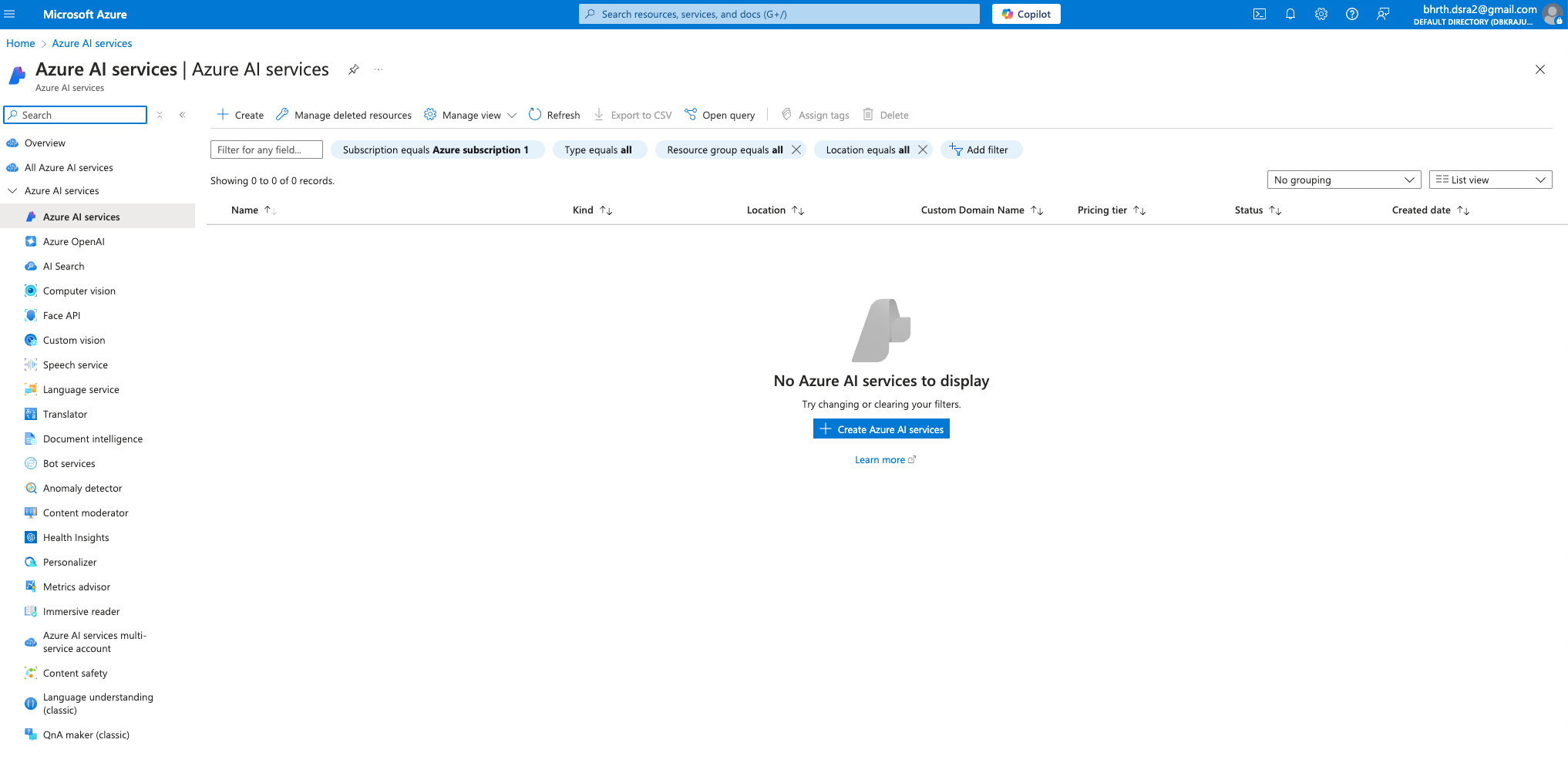
AI Workloads
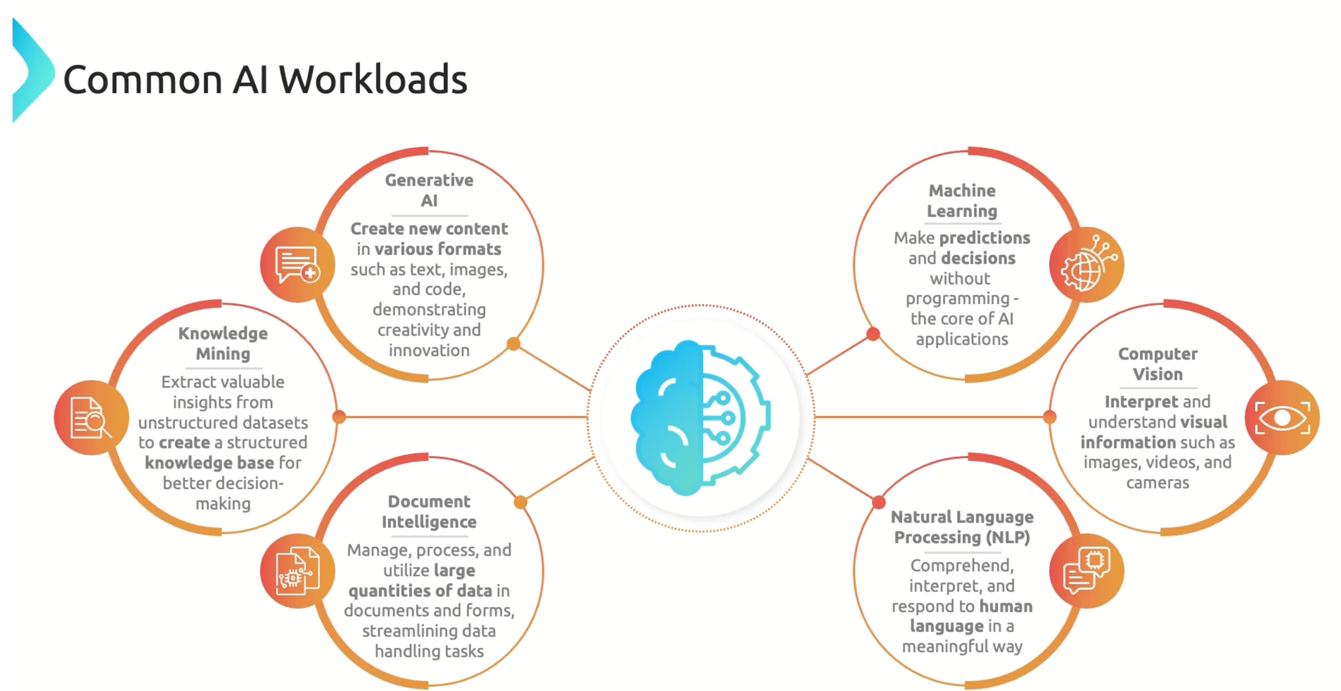
Initial Demo Script
Demo script initializing Azure AI study
1AZURE AI Practioner
2
3Artifical Intelligence - A software that imitates human capabilities - A simulation of human intelligence in machines.
4
5
61. Artificial Intelligence Workloads & Considerations
72. Fundamental Principles of Machine Learning on AZURE
83. Feature of Computer vision workloads on Azure
94. Features of Natual Language Processing (NLP) workoads on Azure
105. Features of Generative AI workloads on Azure
11
12AI usecase:
13-------------------->
141. Prediction and Pattern Recognition
152. Anomaly detection and decision making
163. Visual interpretation
174. Understanding human language and Conversation -(Natural Language Processing - NLP)
185. Information Extraction
19
20
21AI Workloads:
22------------------------>
231. Machine Learning
242. Computer Vision
253. Natual Language Processing - NLP
264. Document Intelligence
275. Knowledge Mining
286. Generative AI
29
30Principles of Responsible AI
31------------------------------------------------->
321. Fairness - need to make unbaised decisions
332. Reliability and Safety - ex: Autonomous vehicles and health care
343. Privacy and security
354. Inclusiveness
365. Transparency
376. Accountability
Azure AI Fundamentals
Azure AI – Machine Learning
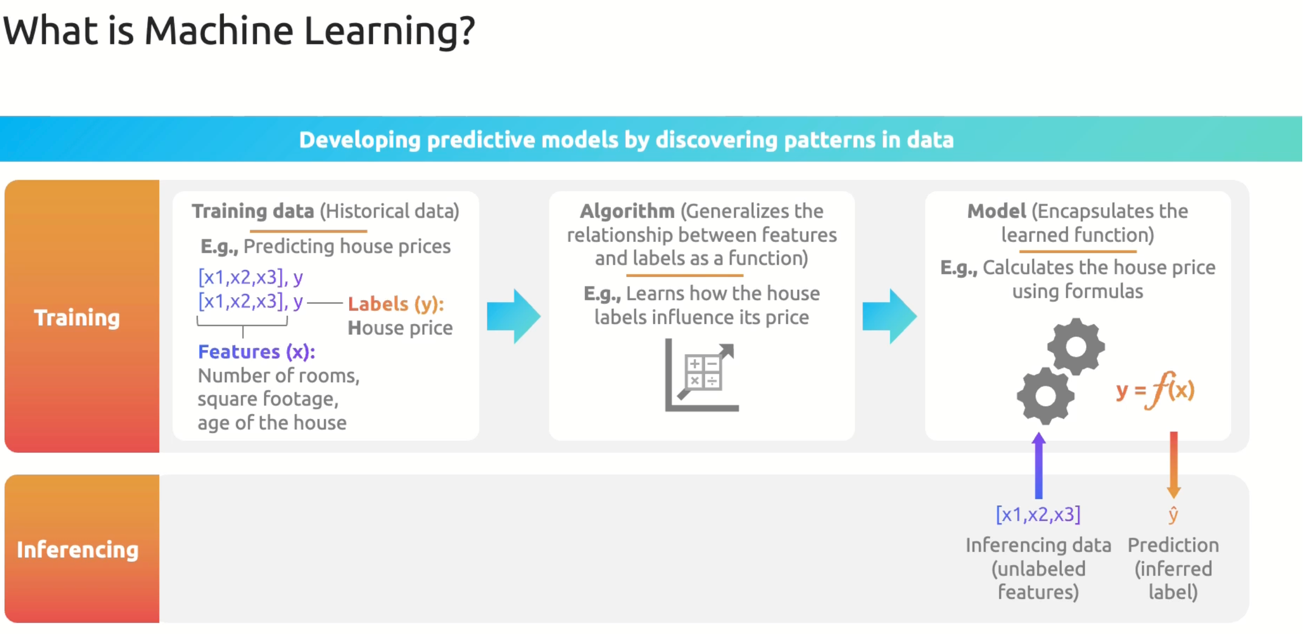
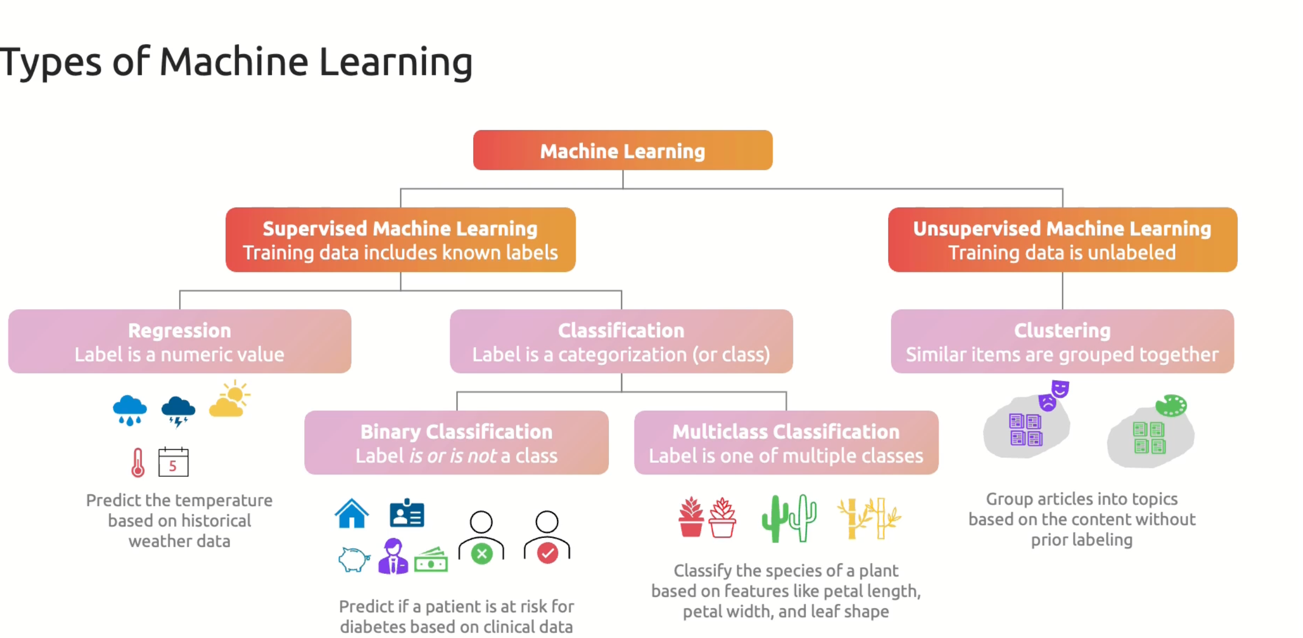
Introduction to Machine Learning
1learn from data -ML
2
3Supervised Learning
4Unsupervised Learning
5Reinforcement Learning
6
7
8
9Deep Learning - Neural Networks
10
11
12Azure ML
13
14ML:
15--->
16ML is about creating predictive models by finding patterns in data.
17This process involves two main phases - Training and Inferencing
18
191. Training Data - Historical data
20 1. Labels and Features
21 2. Algorithm
22 3. Model
23
242. Inferencing
25 1. Train the Model
26 2. Prediction
27
28ML helps us to make informed decisions about the future.
29
30
31ML types:
32-------------->
331. Supervised Machine Learning --> Training data includes known labels.
34 1. Regression - Label is a numeric value
35 2. Classification(Label is a Categorization) - Binary Classification, Multiclass Classification
36
372. Unsupervised Machine Learning --> Training data in unlabeled.
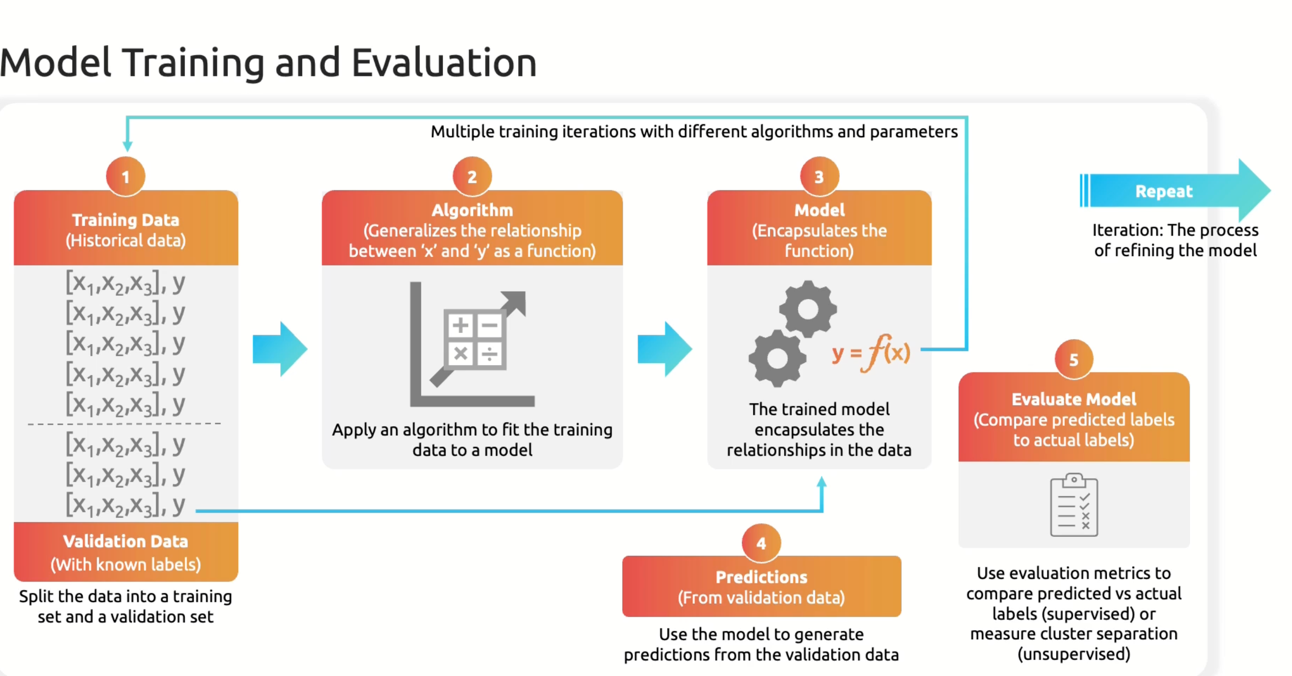
Model Training and Evaluation
11. Training Data - training set and a validation set
22. Algorithm
33. Model
44. Predictions
55. Evaluate Model
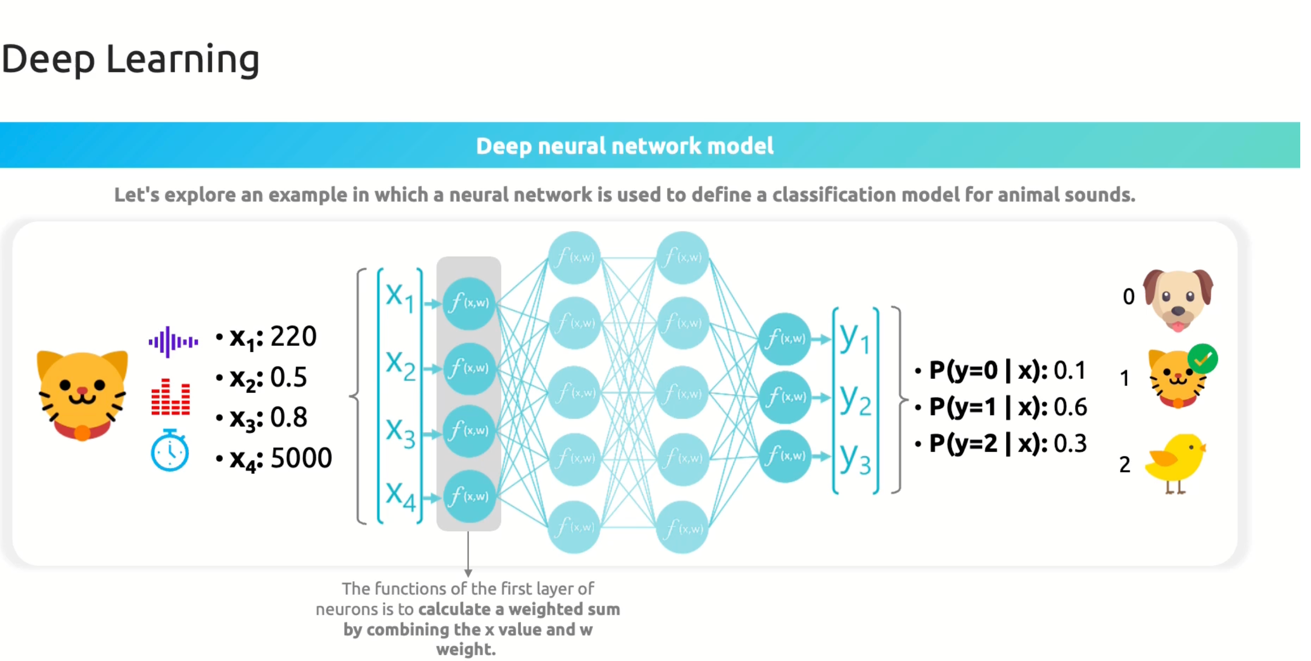
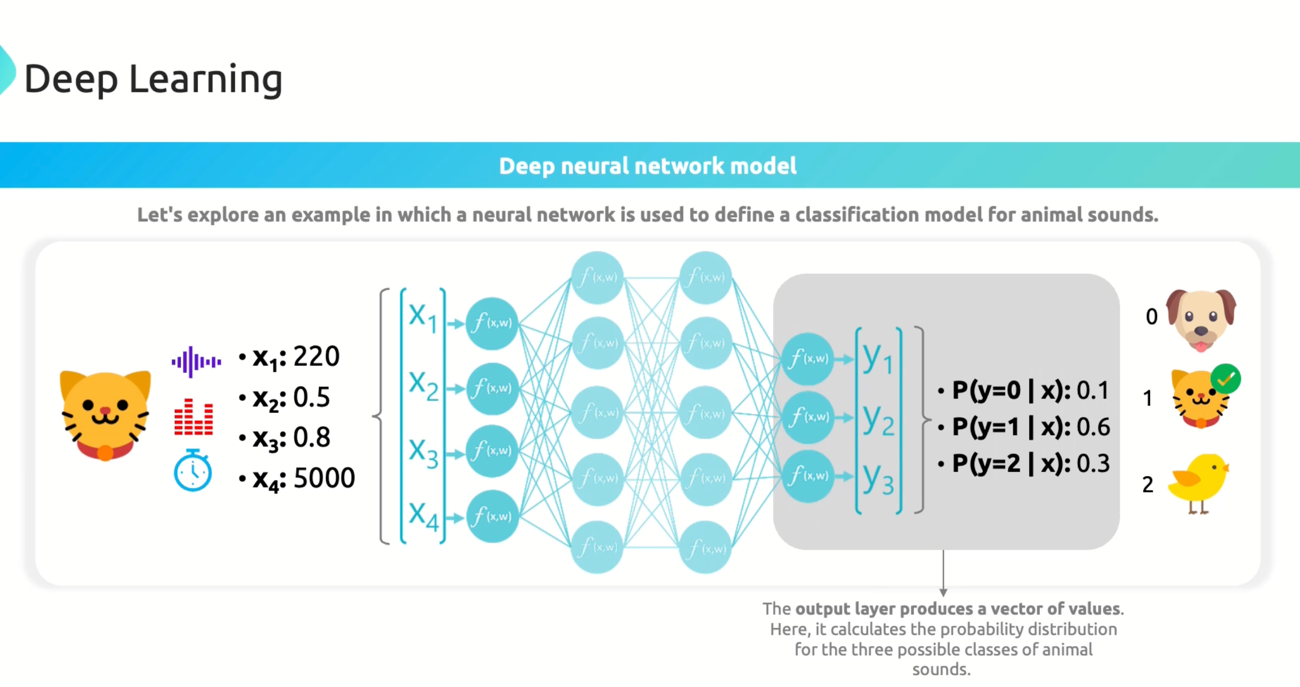
Deep Learning Concepts
1Deep Learning -- Human NEural Network
2
3Articial Neural Network:
4--------------------------->
5
6DNN -- Deep Neural Network -- NLP Natural Language Processing
Azure Machine Learning CLI Commands
1Azure Machine Learning
2
3Azure Tools
4
5Build - Train - DeploY
6
7Azure Machine Learning Studio --
Azure AI
Azure AI Overview
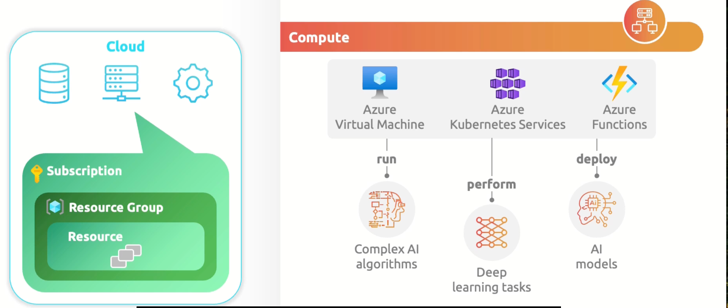
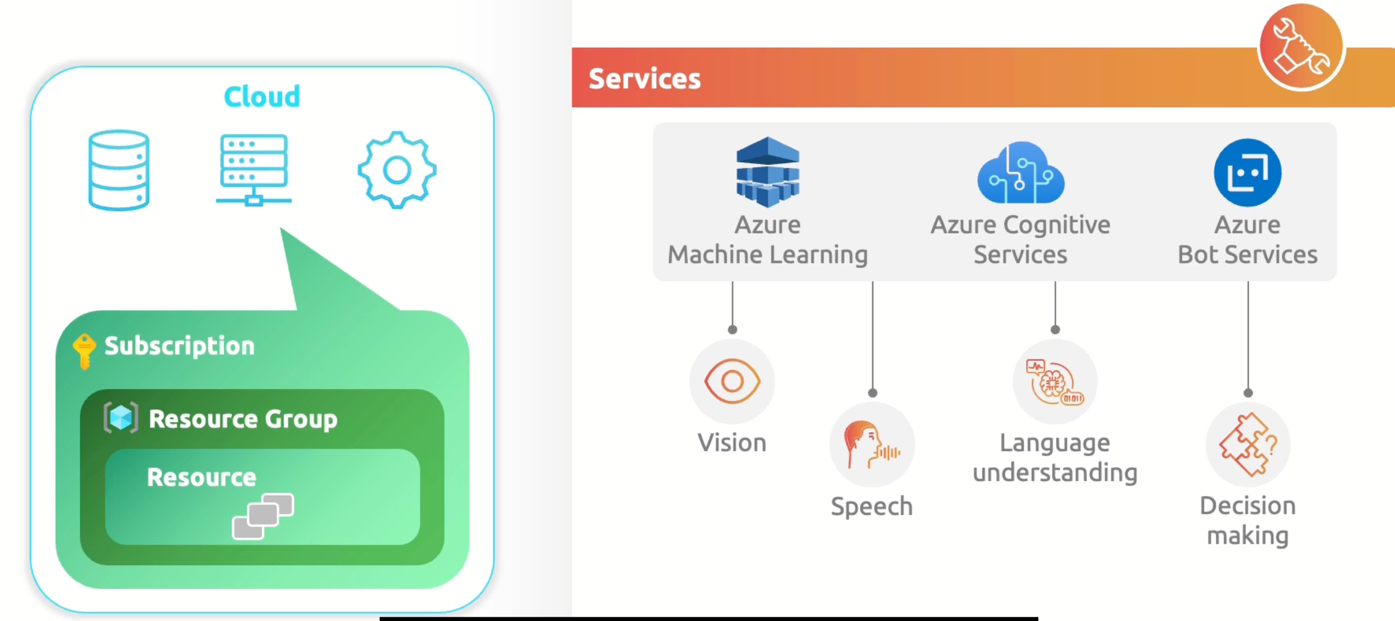
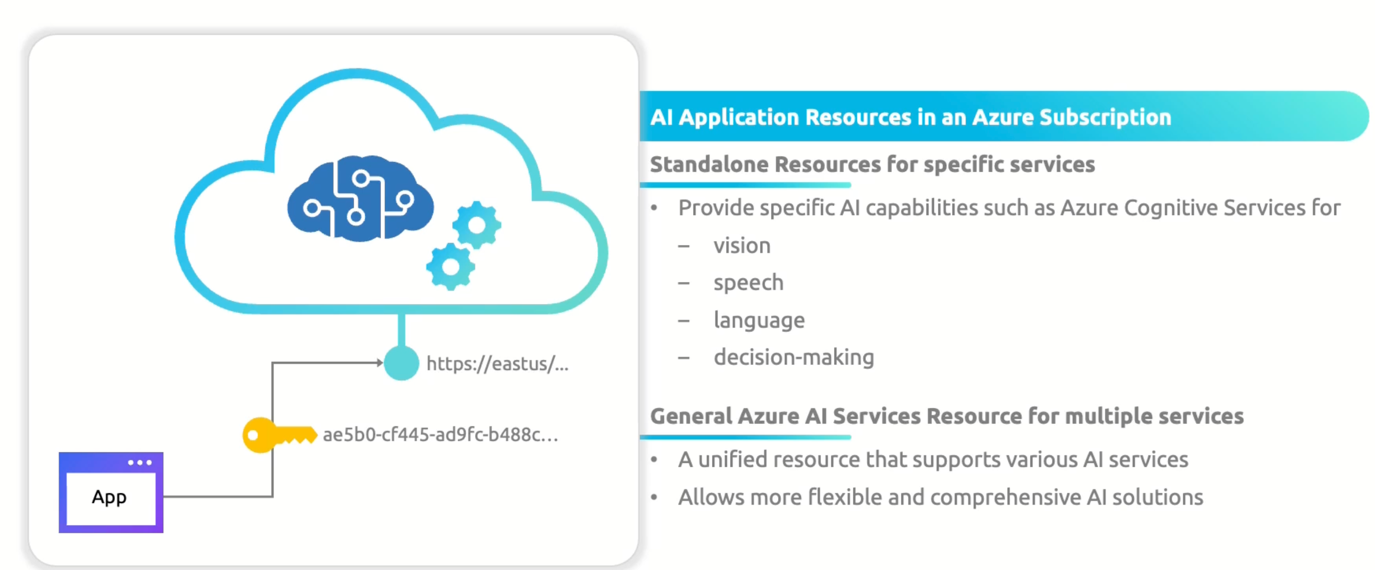
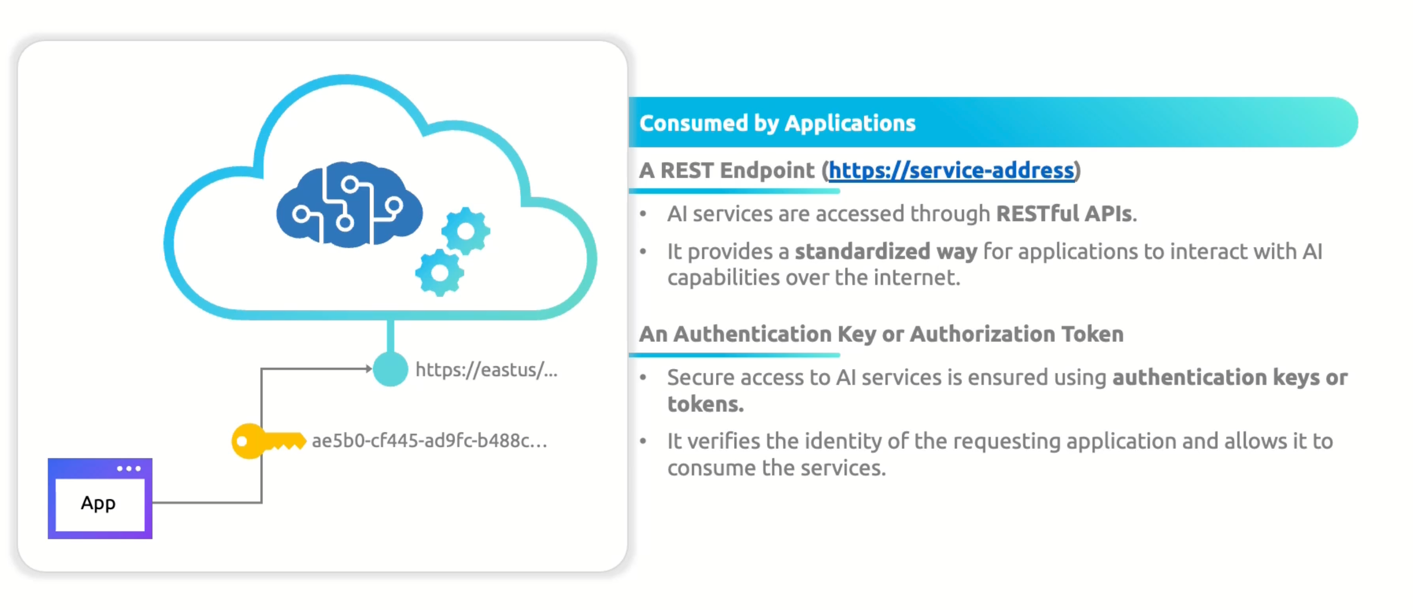
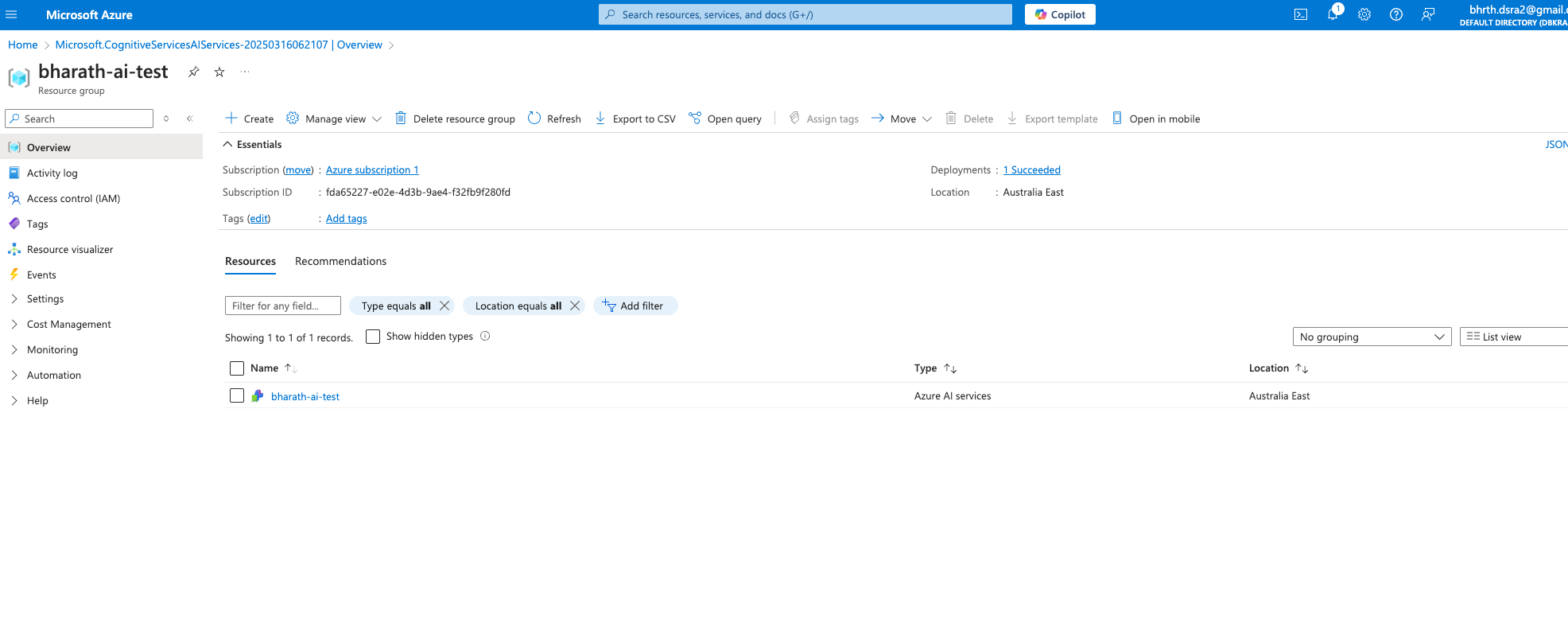
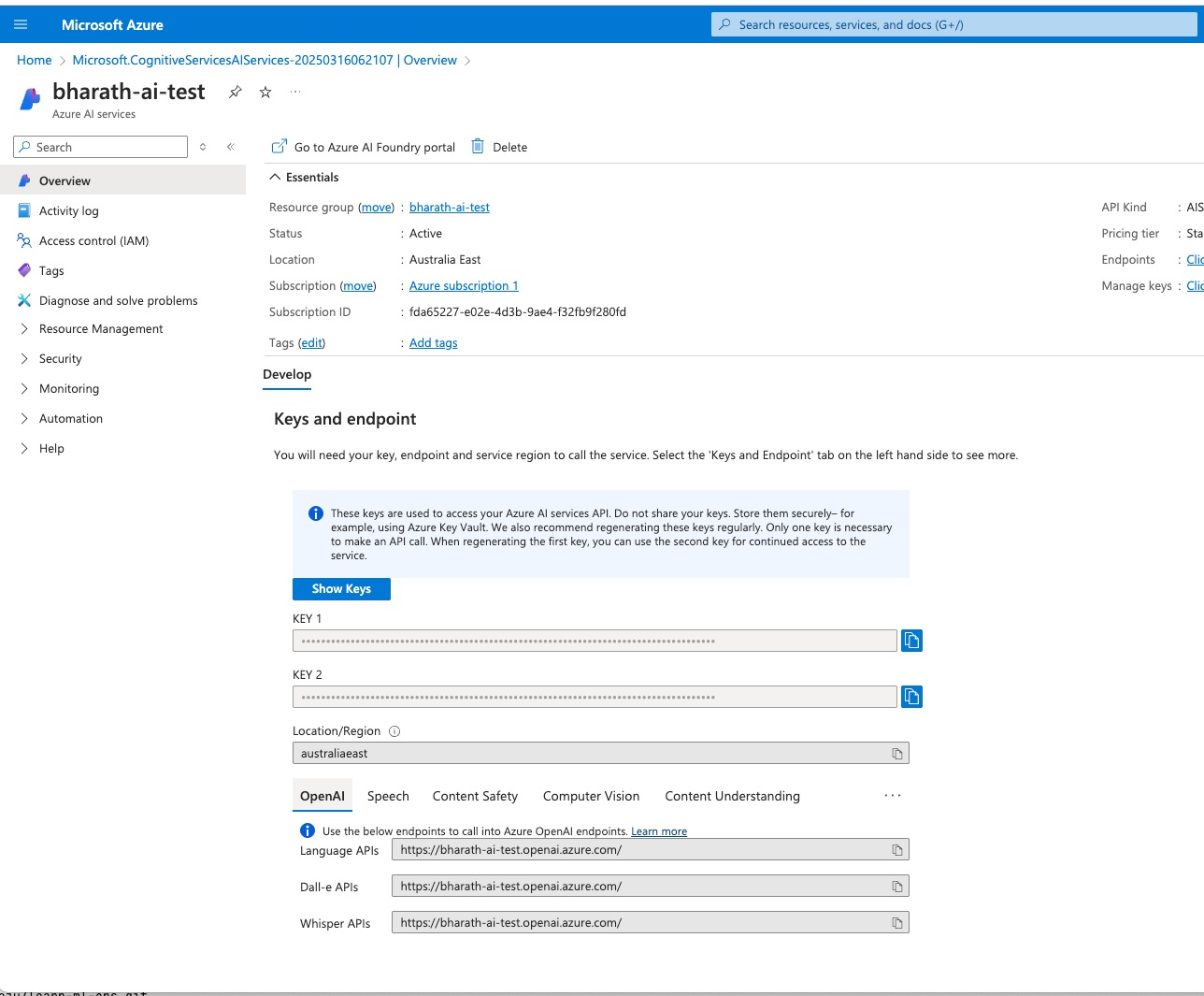
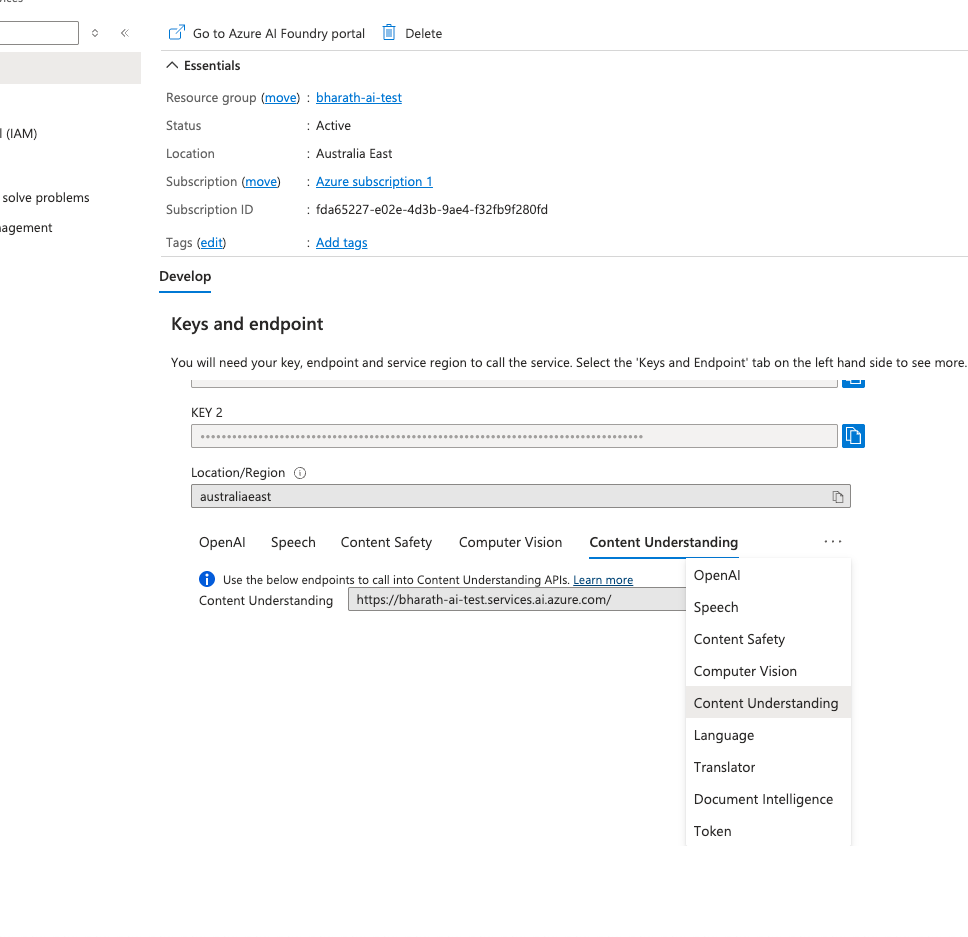
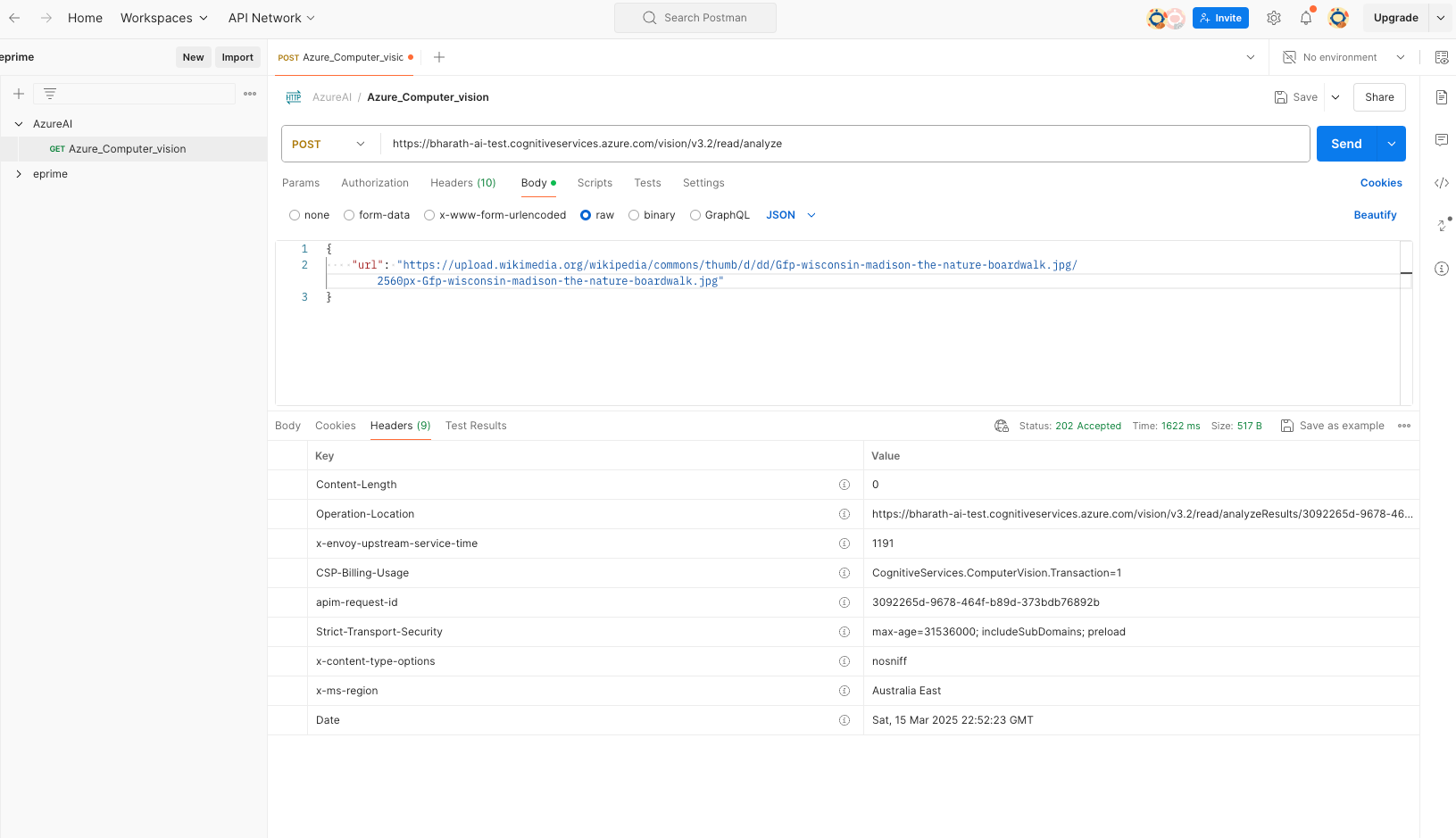

Azure AI Setup Script
Basic Azure AI Setup Script
1Azure blob storage
2
3Azure Data lake storage
4
5
6Azure compute - Azure VM - Azure AKS - Azure Functions
7
8
9AI Services in Azure
10
11Azure Machine Learning:
12------------------------------------------->
13Model Training, Deploying and Management
14
15
16Azure AI Services:
17---------------------------------------->
18Vision
19Speech
20Language
21Decison-making
22Generative AI
23
24Azure Cognitive Search:
25------------------------------------------->
26Data extraction
27Data Enrichment
28Data indexing
29Enhances the search experience
30Facilitates Knowledge discovery through effective data mininng techniques.
31
32
33
34
35Deploy Standalone Resources for specifci services. like vision, speech, language and decision-making
36
37General AI Services Resource for multiple services. - A unified resource that supports various AI services.
38
39
40
41So once we deploy Azure AI services we get the different API Endpoint for different services
42
43OpenAPI Endpoints:
44---------------->
45Language APIs: https://bharath-ai-test.openai.azure.com/
46Dall-e APIs : https://bharath-ai-test.openai.azure.com/
47Whisper APIs: https://bharath-ai-test.openai.azure.com/
48
49Speech ENdpoints:
50-------------------->
51Speech to Text (Standard): https://australiaeast.stt.speech.microsoft.com
52Text to Speech (Neural): https://australiaeast.tts.speech.microsoft.com
53Custom Voice: https://bharath-ai-test.cognitiveservices.azure.com/
54
55Content Safety Endpoints:
56----------------------------->
57content safety: https://bharath-ai-test.cognitiveservices.azure.com/
58
59Computer vision Endpoints:
60-------------------------------->
61computer vision: https://bharath-ai-test.cognitiveservices.azure.com/
Azure Vision API Script
Azure Vision API Call Script
1curl -X POST --location 'https://bharath-ai-test.cognitiveservices.azure.com/vision/v3.2/read/analyze' \
2--header 'Ocp-Apim-Subscription-Key: NaXJ3w3AAAAACOG0QFO' \
3--header 'Content-Type: application/json' \
4--data '{
5 "url": "https://bkr-static-images.s3.ap-southeast-1.amazonaws.com/test.jpg"
6}'
7
8it gives the Operation-Location in headers
9https://bharath-ai-test.cognitiveservices.azure.com/vision/v3.2/read/analyzeResults/e900a652-9c2d-47e9
10
11 now run the GET API call
12
13
14
15bharathkumardasaraju@abex-aws-ansible$ curl -ks --location 'https://bharath-ai-test.cognitiveservices.azure.com/vision/v3.2/read/analyzeResults/e900a652-9c2d-47e9' \
16--header 'Ocp-Apim-Subscription-Key: NaXJ3w3AAAAACOG0QFO' | jq .
17{
18 "status": "succeeded",
19 "createdDateTime": "2025-03-15T23:41:40Z",
20 "lastUpdatedDateTime": "2025-03-15T23:41:40Z",
21 "analyzeResult": {
22 "version": "3.2.0",
23 "modelVersion": "2022-04-30",
24 "readResults": [
25 {
26 "page": 1,
27 "angle": 0.0508,
28 "width": 1520,
29 "height": 1136,
30 "unit": "pixel",
31 "lines": [
32 {
33 "boundingBox": [
34 721,
35 823,
36 758,
37 824,
38 759,
39 838,
40 722,
41 838
42 ],
43 "text": "lash",
44 "appearance": {
45 "style": {
46 "name": "other",
47 "confidence": 0.972
48 }
49 },
50 "words": [
51 {
52 "boundingBox": [
53 721,
54 823,
55 751,
56 823,
57 751,
58 838,
59 721,
60 837
61 ],
62 "text": "lash",
63 "confidence": 0.641
64 }
65 ]
66 },
67 {
68 "boundingBox": [
69 155,
70 992,
71 1149,
72 991,
73 1150,
74 1042,
75 155,
76 1045
77 ],
78 "text": "Caption: A group of people walking on a sidewalk",
79 "appearance": {
80 "style": {
81 "name": "other",
82 "confidence": 0.972
83 }
84 },
85 "words": [
86 {
87 "boundingBox": [
88 157,
89 993,
90 328,
91 992,
92 327,
93 1044,
94 155,
95 1041
96 ],
97 "text": "Caption:",
98 "confidence": 0.996
99 },
100 {
101 "boundingBox": [
102 338,
103 992,
104 366,
105 992,
106 365,
107 1044,
108 337,
109 1044
110 ],
111 "text": "A",
112 "confidence": 0.934
113 },
114 {
115 "boundingBox": [
116 377,
117 992,
118 497,
119 992,
120 496,
121 1045,
122 376,
123 1044
124 ],
125 "text": "group",
126 "confidence": 0.991
127 },
128 {
129 "boundingBox": [
130 507,
131 992,
132 552,
133 992,
134 551,
135 1045,
136 506,
137 1045
138 ],
139 "text": "of",
140 "confidence": 0.997
141 },
142 {
143 "boundingBox": [
144 562,
145 992,
146 701,
147 992,
148 701,
149 1044,
150 561,
151 1045
152 ],
153 "text": "people",
154 "confidence": 0.991
155 },
156 {
157 "boundingBox": [
158 711,
159 992,
160 866,
161 992,
162 867,
163 1042,
164 711,
165 1044
166 ],
167 "text": "walking",
168 "confidence": 0.996
169 },
170 {
171 "boundingBox": [
172 876,
173 992,
174 928,
175 992,
176 928,
177 1041,
178 876,
179 1042
180 ],
181 "text": "on",
182 "confidence": 0.998
183 },
184 {
185 "boundingBox": [
186 937,
187 992,
188 960,
189 993,
190 961,
191 1040,
192 938,
193 1040
194 ],
195 "text": "a",
196 "confidence": 0.994
197 },
198 {
199 "boundingBox": [
200 970,
201 993,
202 1149,
203 994,
204 1150,
205 1034,
206 971,
207 1040
208 ],
209 "text": "sidewalk",
210 "confidence": 0.996
211 }
212 ]
213 },
214 {
215 "boundingBox": [
216 155,
217 1046,
218 1283,
219 1047,
220 1283,
221 1097,
222 155,
223 1096
224 ],
225 "text": "Tags: Building, jeans, street, outdoor, jacket, city, person",
226 "appearance": {
227 "style": {
228 "name": "other",
229 "confidence": 0.972
230 }
231 },
232 "words": [
233 {
234 "boundingBox": [
235 157,
236 1047,
237 256,
238 1047,
239 255,
240 1096,
241 155,
242 1095
243 ],
244 "text": "Tags:",
245 "confidence": 0.996
246 },
247 {
248 "boundingBox": [
249 265,
250 1047,
251 442,
252 1047,
253 441,
254 1098,
255 264,
256 1096
257 ],
258 "text": "Building,",
259 "confidence": 0.995
260 },
261 {
262 "boundingBox": [
263 452,
264 1047,
265 567,
266 1047,
267 567,
268 1098,
269 451,
270 1098
271 ],
272 "text": "jeans,",
273 "confidence": 0.997
274 },
275 {
276 "boundingBox": [
277 577,
278 1047,
279 712,
280 1047,
281 712,
282 1098,
283 577,
284 1098
285 ],
286 "text": "street,",
287 "confidence": 0.995
288 },
289 {
290 "boundingBox": [
291 722,
292 1047,
293 895,
294 1048,
295 896,
296 1097,
297 722,
298 1098
299 ],
300 "text": "outdoor,",
301 "confidence": 0.994
302 },
303 {
304 "boundingBox": [
305 905,
306 1048,
307 1036,
308 1048,
309 1037,
310 1097,
311 905,
312 1097
313 ],
314 "text": "jacket,",
315 "confidence": 0.996
316 },
317 {
318 "boundingBox": [
319 1046,
320 1048,
321 1130,
322 1049,
323 1131,
324 1096,
325 1047,
326 1097
327 ],
328 "text": "city,",
329 "confidence": 0.997
330 },
331 {
332 "boundingBox": [
333 1139,
334 1049,
335 1280,
336 1049,
337 1281,
338 1094,
339 1140,
340 1096
341 ],
342 "text": "person",
343 "confidence": 0.996
344 }
345 ]
346 }
347 ]
348 }
349 ]
350 }
351}
352bharathkumardasaraju@abex-aws-ansible$
Azure AI Vision
Azure AI Vision - Foundry Portal
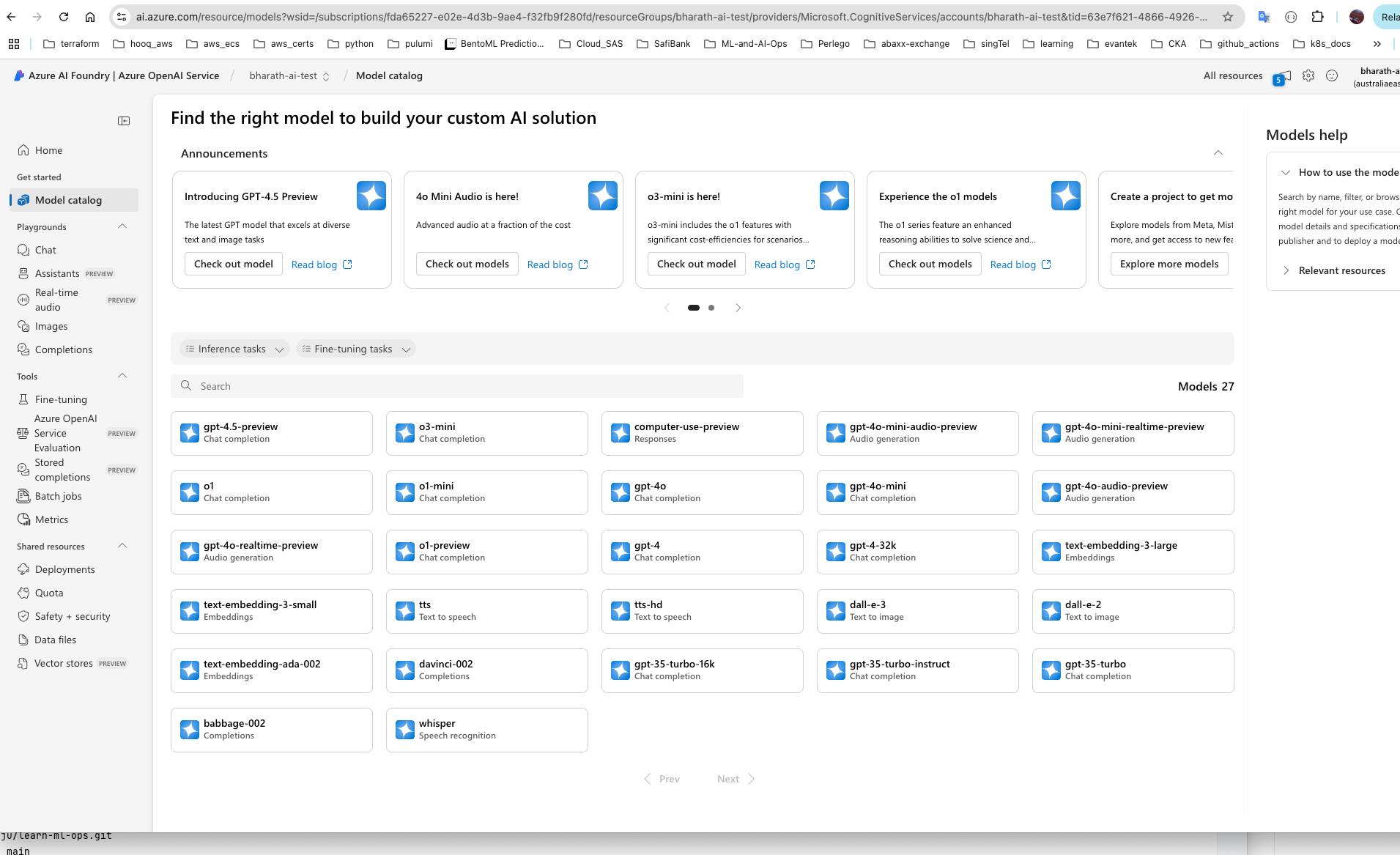
Convolutional Neural Networks (CNN)
Introduction to CNN in Azure AI
1Convolutional Neural Networks
2
3CNNs use filters to extract features from the image and then flatten the feature maps into fully connected layers for classification or prediction.
Multi-Modal Models
Azure AI Multi-Modal Models Example
1analyzes multiple types of content... text, images etc...
2
3 1. Foundation models
4 2. Adaptive models
5
6Microsoft Florence Model -- used for image Analysis capabilities in Azure AI vision and multi-modal Model.
Azure AI Vision Services
Azure AI Vision Services Setup Script
1Azure Vision Services
2
3 OCR - Optical Character Recognition(OCR)
4 Spatial ANalysis
5
6
7Azure Facial Services
8 Face Detection
9 Face Recognition
10
11
12Image ANalysis using vision studio
13
14
15AI Vision Service and Image ANalysis:
16
17Extract & Process text from image.
18captions
19crop images
20
21Azure AI Foundry Portal:
22
23OCR - Optical Character Recognition(OCR)
Azure Natural Language Processing (NLP)
What is NLP in Azure?
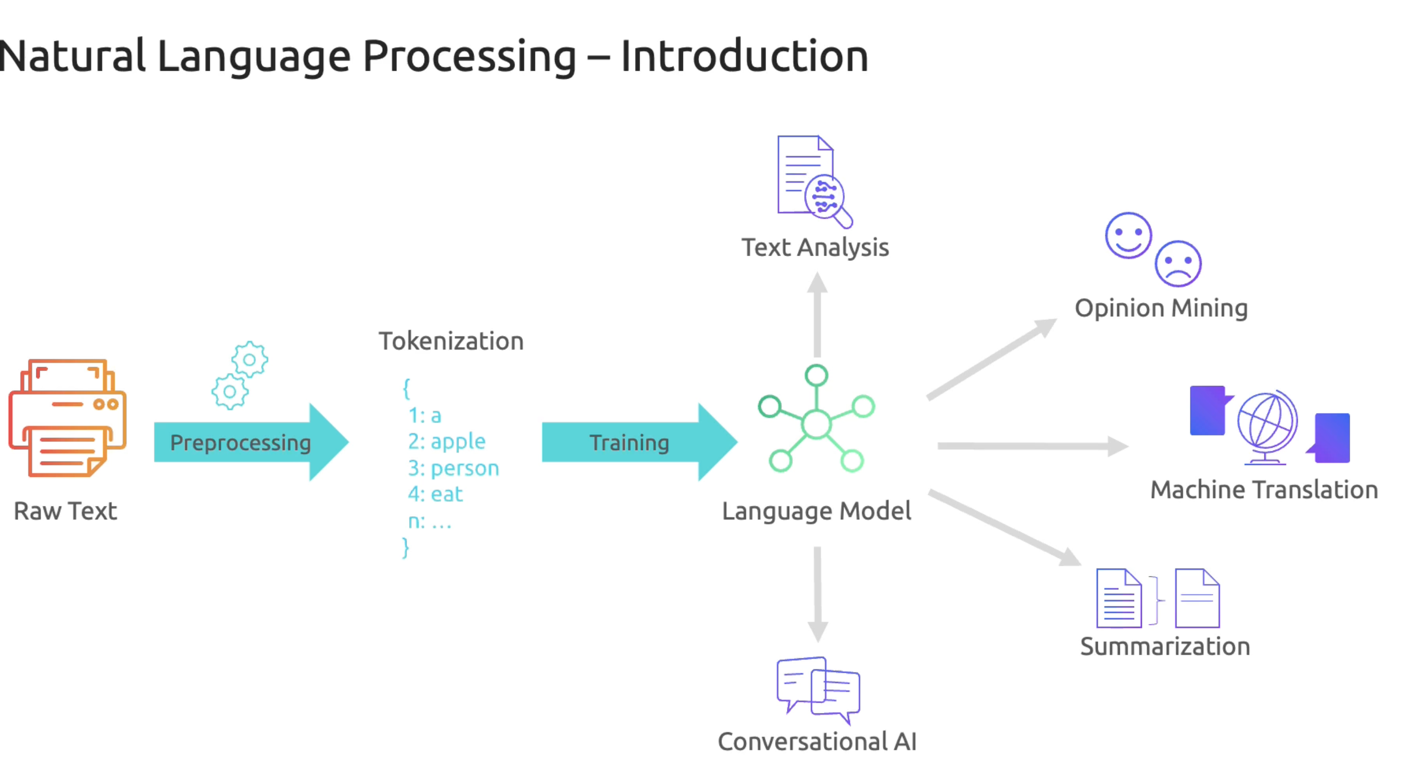
Intro to Azure NLP
1Azure Natural Language Processing(NLP)
2
3AN AI mechanism...
4
5NLP focuses on helping computers to understand, interpret and respond to human language in a meaningful way.
6
7
8Raw Text
9
10Raw Text preprocessing --> tokenization --> Training --> Language Model
11
12
13Text Analysis
14Opinion Mining
15Machine Translation
16Summarization
17ConversationalAI (chatbots)
Azure NLP Services Overview
Using NLP in Azure AI
1NLP:
2--------------------->
3
41. Language
5lanaguage detection
6key phrase extraction
7personal info detection
8conversational lanaguage understandinn
9
102. Speech
11text to speech
12speech to text
13speech translation
14language identification
15
163. Translation
17text translation
18Document translation
19custom translation
Text Analysis in Azure
Azure Text Analysis Capabilities
1extract text for meaningful insights
2
3Text analysys from Language Studio Service
4
5detects
61. Predominant Language
72. Sentiment
83. Key Phrases
94. Named Entities
10
11Question and Answering API service from the Language Studio service in Azure.
12knowledge base
13
14Built-in Conversational chit-chat
Azure Speech-to-Text Capabilities
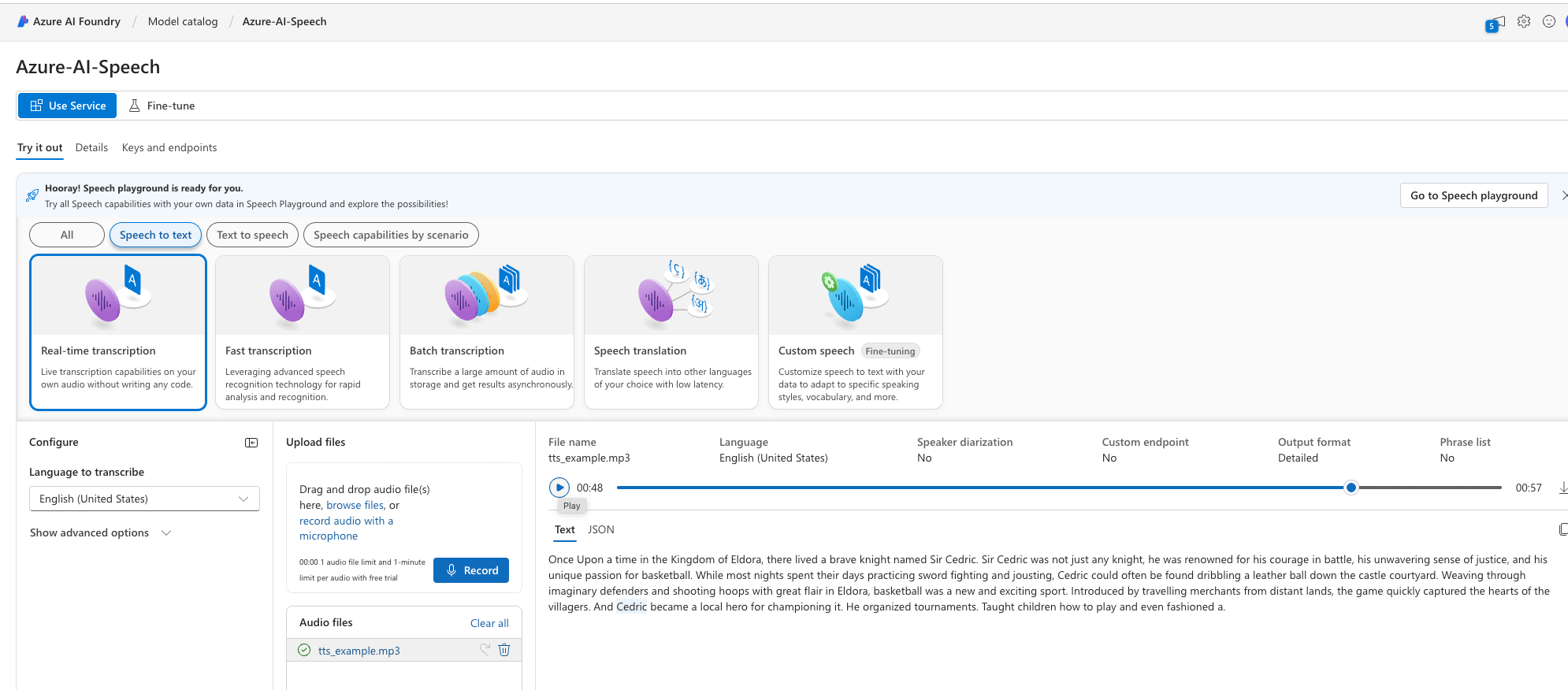
Azure Bot Services
Azure Bot Service Integration
1intelligent bots engage with user in a natural way.
2
3
4Azure bot service can integrate with AI language services -
5 1. Natural language understading
6 2. Sentiment Analysis
7
8Connectovity through multiple channels --
Conversational Language Support in Azure
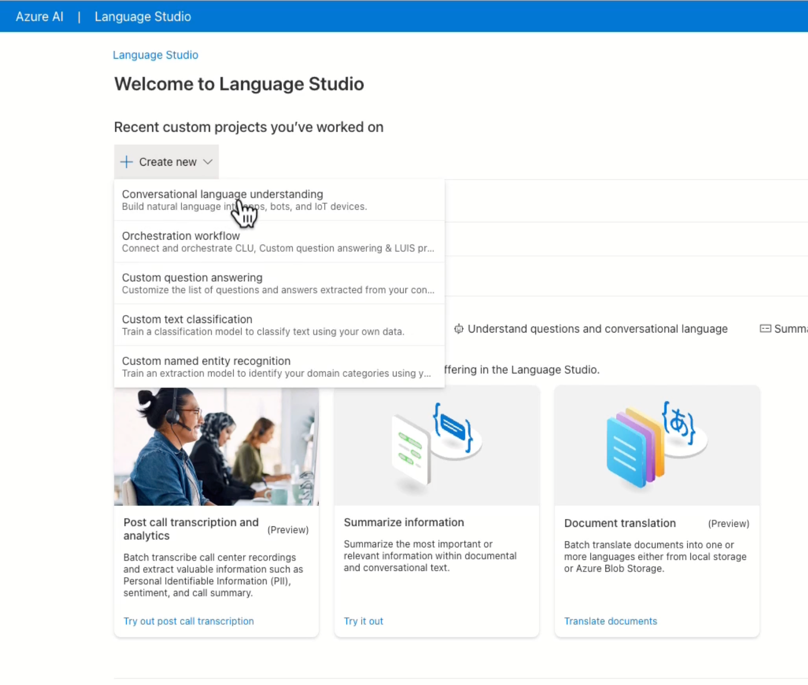
Conversational Language in Azure AI
11. Utterance
22. INtent
33. Entity
4
5 users input --> intent --> ENtity
6
7
8 Language Studio --> Conversational Language Understanding.
Speech Recognition with Azure
Speech Recognition Example
1Speech Recognition and Speech Synthesis
2
3speech Studio
Azure Document Intelligence
Introduction to Azure Document Intelligence
Using Azure AI for Document Intelligence
1Form Analysis using document intelligence
2
3Document Intelligence Studio
4
5Document Analysis
6Pre-Built models for
71. INvoices
82. REceipts
93. ID Documents
10
11Custom-models:
12custom models with sample data.
13Field identification
Azure AI Search
Azure AI Enrichment Workflow
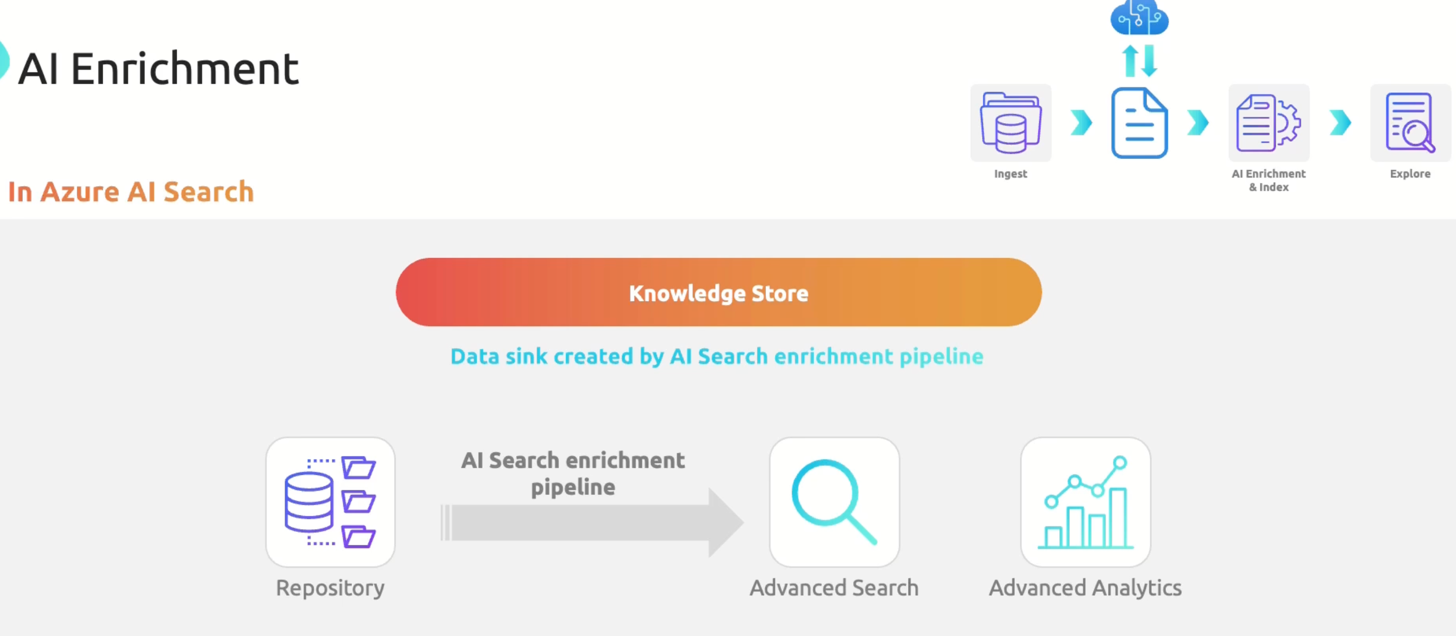
Azure AI Search Script
Azure AI Search Usage
1how to extract the vast amounts of data.
2
3Azure AI Search services - How Azure AI helps to build intelligent search solutions
4
5AI ENrichment
6
7Azure AI Search INdex
8
9
10
11Data Mining:
12----------------->
13Search and bots
14
15
16Azure AI Search Services:
17--------------------------------->
18
19ingest:
20------------>
211. Azure blob storage containers
222. Azure SQL Database, Documents in Cosmos DB
233. Azure Data Lake Storage Gen2
244. Azure Table Storage - Store structured NoSQL data
25
26
27AI Enrichment and Index:
28----------------------------->
29
30Explore:
31------------>
32Search performed on INdexes
33
34
35AI search service in .... Azure AI services.
36
37
38
39AI ENrichment:
40------------------------->
41skillsets - identfies entities in text
42Evaluates Sentiment
43Translate text
GenAI in Azure AI
Transformer Models in GenAI
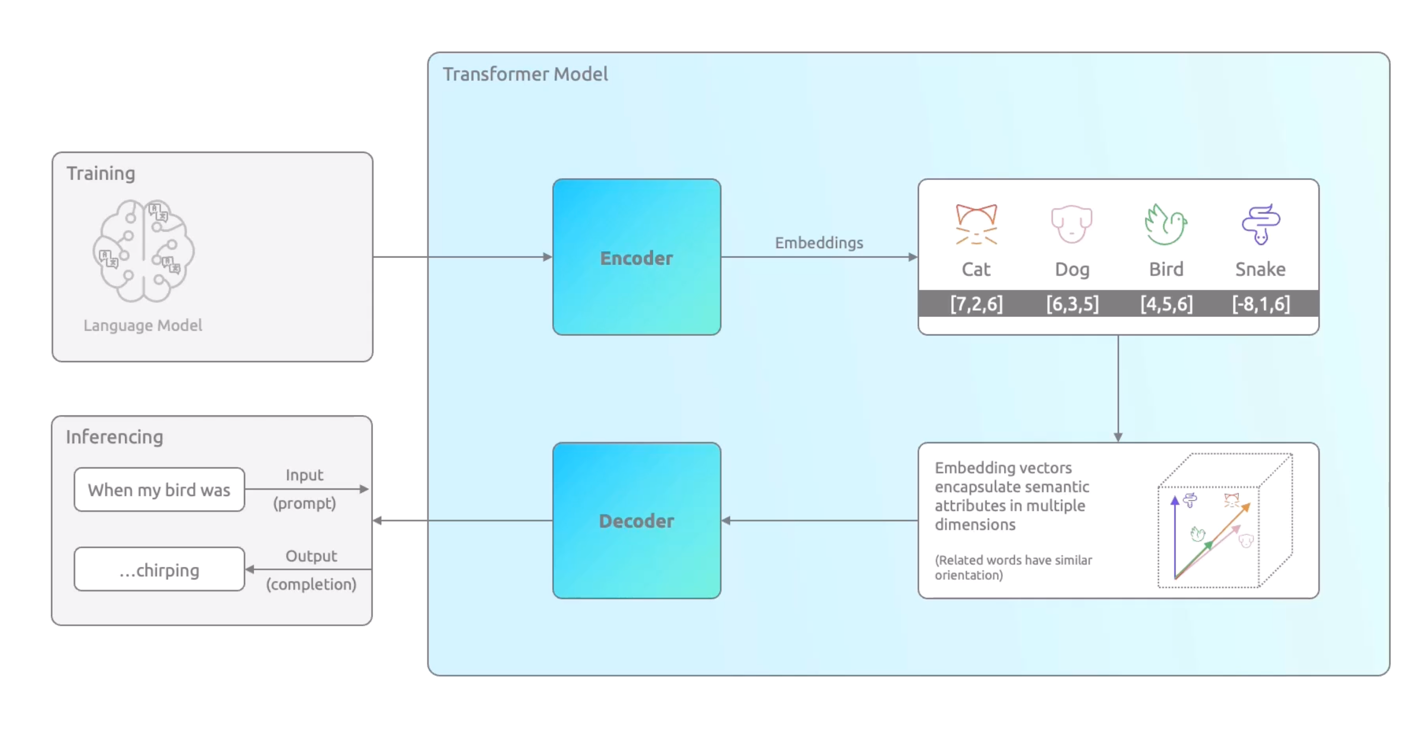
Introduction to GenAI in Azure
1Large Language Model:
2--------------------------------->
31. Natural Language generation
42. Image Generation
53. Code Generation
6
7
8Language Models:
9-------------------------->
10How AI been trained to make decisions like human is like this ---
11
12AI uses transformer model. It has two parts, the Encoder and Decoder.
13
14First we feed the model with large amount of data. This could be from book, scientific papers that helps the model to learn language patterns.
15
16Then we feed this data to transformer model -
17
18So the encoder will take these words and converts them into floating pointing numbers, which are known as embeddings.
19Each word that means each embeddings gets mapped to as set of coordinates in a multi-dimensional space.
20
21Now that the model has learned from all this data, It can start making predictions.
22
23So when user give it a prompt,
24Like ---- When my bird was the decoder uses the embeddings and patterns it learned during the training to generate a natural language sequence -
25So in this case, it might suggest chirping as completion.
Language Training with Azure AI
Language Model Training
1Language training done in 3 steps
2
31. Tokenization
42. Embeddings
53. Attention
6
7Tokenization breaks sentence down into numbers that the model can process.
8Embeddings helps the model to understand the relationship between words by positioning them in a meaning based space.
9Attention allows the model to focus on the most relevant words when making predictions
10
11
12Founadational Model
13
14Pre-trained Foundational model
Microsoft Copilot
Microsoft Copilot Overview
1Generative AI-Powered Assistants integrated into applications often as chat interfaces.
2
3Copilots helps contextual assistance in everyday tasks.
4
5
6
7Extend AI Copilot with custom integration.
8Develop personalized copilots.
9
10Copilot services offered by Microsoft:
11------------------------------------------------------------->
121. Daily Tasks
132. Business Processes
143. INfra, security and software development
15
16PowerBI
17
18github copilot
19
20Effective prompting is all about ---> clarity, context and specificity
21
22Copilot is AI-powered Assistant
23
24
25Copilot Studio and Azure AI Studio
Azure OpenAI
Azure OpenAI Platform
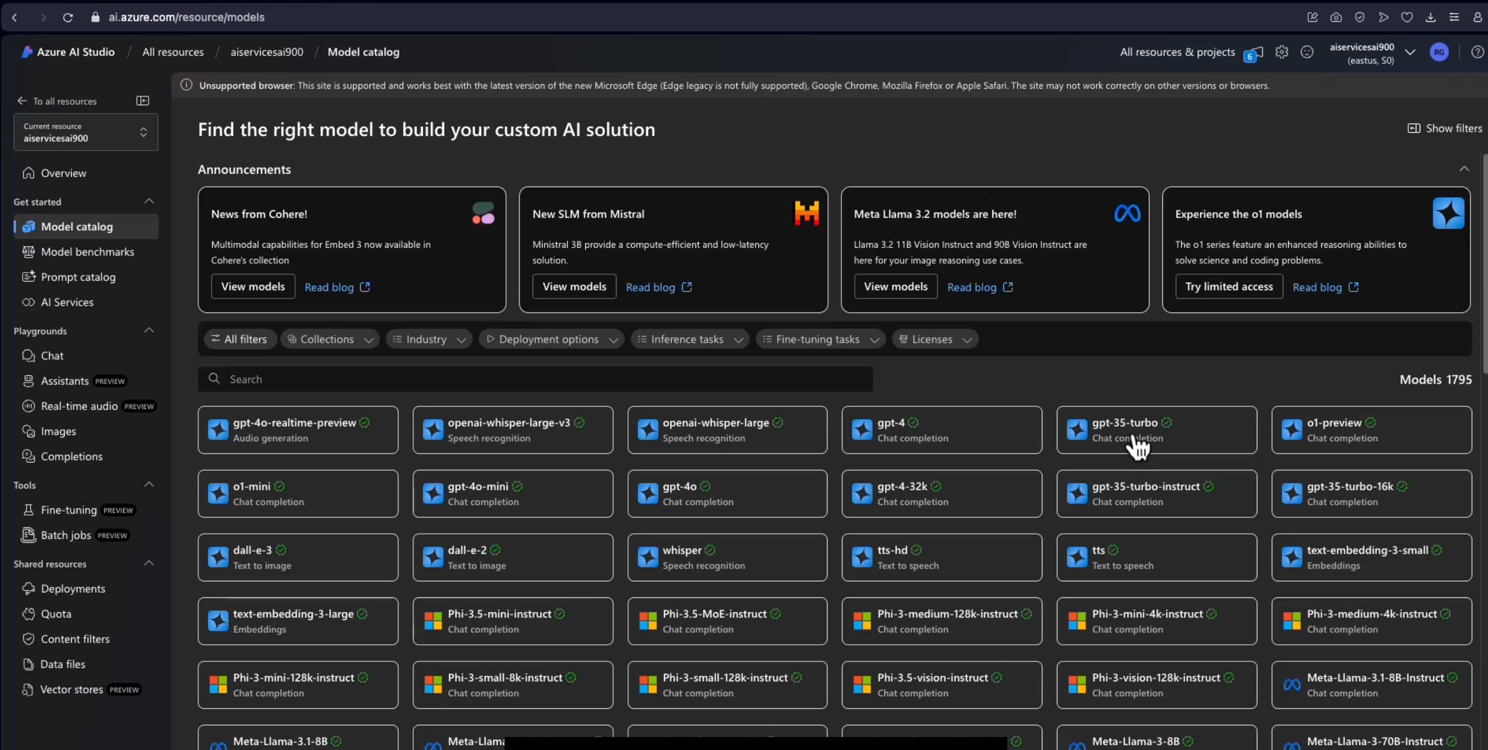
Overview of Azure OpenAI Services
1Azure OpenAI service designed specifically for deploying, customizing and hosting large language models.
2
3
4Azure OpenAI Provides
51. Pre-Trained AI models
62. Model Customization
73. Responsible AI tools
84. Enterprise security features
9
10Azure AI Studio
11REST API
12Supported SDKs
13Azure CLI
14
15
16Models Supported AzureOpenAI
17
18GPT-4o and GPT-4 Turbo
19GPT-3.5
20Embeddings model
21DALL-E
22Whisper - speech recoginition model
23
24
25Capabilities of Azure OpenAI
26----------------------------------------------------->
27
28Azure OpenAI Studio
291. Model Deployment
302. Generatibe AI
313. Supported Models
32
33OpenAI Playgrounds
341. Experimentation
352. Configuration
36
37GPT - Generative Pre-trained transformer models
Azure AI Topics - Demo
Demo Script
Azure AI Topics Demonstration
1Determining whether an email is spam or not,
2Predicting a customers likelihood of repaying a loan,
3Detecting fraudulent credit card transactions,
4Identifying whether an image contains a cat or a dog
5
6Classification models are used when the task involves categorizing data into predefined labels or classes.
7
8Examples include identifying spam emails, assessing loan repayment likelihood classifying as likely or unlikely to repay,
9detecting fraud (fraud or no fraud), and
10distinguishing between different objects in images (cat or dog).
11
12Clustering tasks (like grouping customers) and forecasting (predicting sales figures) are not classification tasks but rather clustering and regression, respectively.
13
14----------------------------------------------------------------------------------------------------------------------------------------------------------------------->
15
16The Text Analytics API provides services for language detection, key phrase extraction, entity recognition, and sentiment analysis
17
18
19----------------------------------------------------------------------------------------------------------------------------------------------------------------------->
20
21
22Clustering models are generally evaluated based on metrics that assess the compactness and separability of clusters, such as the average distance to the cluster center.
23Combined evaluation can include measures like intra-cluster distance and silhouette score.
24
25RMSE, accuracy, precision, and coefficient of determination are more typical of regression and classification models.
26
27----------------------------------------------------------------------------------------------------------------------------------------------------------------------->
28
29 The "Explain best model" option aligns with Microsofts Responsible AI principles, particularly transparency.
30
31 By providing explanations for the best-performing model, Azure Machine Learning allows users to understand how the model makes decisions,
32 ensuring that AI systems are interpretable, trustworthy, and transparent.
33
34 This is crucial for responsible AI deployment, helping users understand, debug, and trust the AIs outputs.
35
36 ----------------------------------------------------------------------------------------------------------------------------------------------------------------------->
37
38 Azure Machine Learning Studio offers various types of compute resources including
39 Compute Instances for development,
40 Compute Clusters for scalable training,
41 Kubernetes Clusters for deployment, and
42 Attached Compute for using external compute resources.
43
44 ----------------------------------------------------------------------------------------------------------------------------------------------------------------------->
45
46(Root Mean Squared Error (RMSE),
47R-Squared (Coefficient of Determination),
48Mean Absolute Error (MAE),
49Mean Squared Error (MSE)):
50
51For regression models, Azure ML typically evaluates performance using metrics like
52RMSE,
53MAE,
54MSE, and
55R-Squared.
56
57These metrics help determine how closely the predicted values match the actual values.
58
59Metrics like accuracy, precision, and recall are more appropriate for classification tasks rather than regression.
60
61----------------------------------------------------------------------------------------------------------------------------------------------------------------------->
62
63Utterances,
64Intents,
65Entities
66For training language models, especially for natural language processing tasks like conversational AI,
67key elements include
68utterances (sample phrases that users might say),
69intents (the purpose or goal behind an utterance), and
70entities (specific information or variables extracted from the utterances).
71
72These components help the model understand and process language inputs effectively.
73Vocabulary and general text samples can also be useful depending on the task, but the listed components are essential for creating structured conversational models.
74
75----------------------------------------------------------------------------------------------------------------------------------------------------------------------->
76
77Detecting tumors on X-ray images,
78Visual product search,
79Face recognition,
80Categorizing animal species from photos
81
82Image classification is a technique that identifies the category to which an object in an image belongs
83
84Examples include
85detecting medical conditions (e.g., tumors in X-rays),
86recognizing and searching products visually,
87identifying faces, and
88classifying images of animals.
89
90Recognizing text in images typically falls under optical character recognition (OCR), while
91entity recognition is a natural language processing (NLP) task related to text analysis, not image classification.
92
93----------------------------------------------------------------------------------------------------------------------------------------------------------------------->
94
95Personal Digital Assistants primarily rely on the Bot Framework,
96which allows for natural language processing and interaction with users, integrating various services such as Speech and Text Analytics
97
98----------------------------------------------------------------------------------------------------------------------------------------------------------------------->
99
100 Semantic Segmentation is the process of classifying each pixel in an image to associate it with a particular object class.
101 This allows for a more detailed understanding of the image, beyond simple object detection or classification.
102
103----------------------------------------------------------------------------------------------------------------------------------------------------------------------->
104
105Recall, also known as sensitivity, is calculated as the
106ratio of True Positives (TP) to the sum of True Positives and False Negatives (TP+FN).
107It measures how well the model identifies all relevant positive cases
108
109----------------------------------------------------------------------------------------------------------------------------------------------------------------------->
110
111 Using all the data for training and then reusing it for validation can lead to overfitting and inaccurate validation results.
112 It is crucial to separate the data into training and validation sets to correctly evaluate the models performance
113
114
115----------------------------------------------------------------------------------------------------------------------------------------------------------------------->
116
117Accountability:
118Building AI solutions under legal and ethical standards aligns with the Principle of Accountability.
119It ensures that AI development and deployment follow best practices and guidelines to prevent misuse or harm.
120
121----------------------------------------------------------------------------------------------------------------------------------------------------------------------->
122
1230:
124In a well-performing regression model,
125the residuals (differences between actual and predicted values) should cluster around 0,
126indicating that the models predictions are generally accurate.
127
128----------------------------------------------------------------------------------------------------------------------------------------------------------------------->
129
130
131Speech recognition services primarily rely on two key models:
132
133Language Model: It helps in understanding and predicting the structure of language by determining the likelihood of word sequences.
134Acoustic Model: It maps audio signals to phonemes, which are the smallest units of sound in speech, aiding in the accurate recognition of spoken words.
135
136Other models like image classification, object detection, and speaker identification are not directly involved in the core speech recognition process.
137
138----------------------------------------------------------------------------------------------------------------------------------------------------------------------->
139
140
141By clearly explaining the capabilities and constraints of the AI system, you ensure transparency.
142It allows users to understand how the system works, building trust and ensuring responsible AI use.
143
144----------------------------------------------------------------------------------------------------------------------------------------------------------------------->
145
146
147Clustering is used for grouping similar data points together without predefined labels.
148However, predicting whether members favor the service or not is a classification problem, where the goal is to assign data points to specific classes (favor or not favor).
149Therefore, classification modeling would be more appropriate.
150
151----------------------------------------------------------------------------------------------------------------------------------------------------------------------->
152
153formula to calculate model accuracy
154
155Semantic segmentation is used to classify each pixel in an image,
156making it possible to identify and distinguish different regions, such as flooded and non-flooded areas, within an image.
157This is ideal for tasks that require detailed, pixel-level classification.
158
159----------------------------------------------------------------------------------------------------------------------------------------------------------------------->
160
161An application scans a document and retrieves page information, lines, and words, along with confidence levels. What API is best suited for this?
162
163Read API:
164
165The "Read" API in Azures Cognitive Services is specifically designed to scan and analyze documents,
166extracting text information with details about pages, lines, and words.
167It is an advanced Optical Character Recognition (OCR) that can handle complex documents.
168----------------------------------------------------------------------------------------------------------------------------------------------------------------------->
169
170Azure Cognitive Face service detects emotions such as happiness (smile), surprise, fear, contempt, and neutrality, among others.
171Emotions like "hate" or "sparkle" are not included in the standard set of recognized expressions
172
173----------------------------------------------------------------------------------------------------------------------------------------------------------------------->
174
175The Basic Bot template provides a simple bot framework but does not include language understanding capabilities by default.
176To create a chatbot that understands user intents and entities,
177you should use a template that integrates with Language Understanding Intelligent Service (LUIS) or another natural language processing tool,
178such as the "LUIS Bot" template. This would allow the bot to interpret and respond to user inputs more intelligently.
179
180----------------------------------------------------------------------------------------------------------------------------------------------------------------------->
181
182Live speech translation involves
183converting spoken language to text,
184detecting the language,
185translating the text,
186and then converting it back to speech in the target language.
187
188These components work together to provide seamless translation.
189
190----------------------------------------------------------------------------------------------------------------------------------------------------------------------->
191
192When deploying a Custom Vision model, developers need the
193Project ID to identify the model,
194the Prediction key for authentication, and the
195Prediction endpoint to send requests to the service
196
197----------------------------------------------------------------------------------------------------------------------------------------------------------------------->
198
199an image containing three dogs sitting near a bicycle, a car, and a tree. How many distinct classes will semantic segmentation identify in this image>?
200
2015: Semantic segmentation identifies and classifies distinct object types in an image. In this example,
202the classes are "dog," "bicycle," "car," "tree," and the "background."
203Even though there are three dogs, they belong to the same class.
204Each type of object is counted as one class, so there are five classes in total.
205
206----------------------------------------------------------------------------------------------------------------------------------------------------------------------->
207
208Clip Art, Photo:
209
210The Analyze Image API can classify images based on their content type, specifically identifying whether an image is a
211"Photo" (a real-world picture captured by a camera) or
212"Clip Art" (a graphical image, often simplified and stylized).
213This helps in understanding the nature of the image and applying relevant processing or filtering techniques.
214
215----------------------------------------------------------------------------------------------------------------------------------------------------------------------->
216
217Feature selection): Feature selection is essential in the pre-processing stage.
218
219It involves selecting the most relevant variables (features) from the dataset that are likely to influence the target outcome,
220in this case, predicting the success of the new car model. It helps improve model performance by reducing the complexity of the data.
221
222----------------------------------------------------------------------------------------------------------------------------------------------------------------------->
223
224- Accuracy: measures the overall correctness of predictions.
225- Precision: indicates how many of the predicted positives are true positives.
226- Recall: measures how many of the actual positives were correctly identified by the model.
227
228These metrics provide insights into the models ability to detect objects correctly and minimize false positives and negatives.
229Other metrics like MSE are more relevant for regression tasks, not classification or object detectio
230
231----------------------------------------------------------------------------------------------------------------------------------------------------------------------->
232
233Image classification): Image classification involves identifying objects within an image and categorizing them.
234For a visual product search, the application needs to recognize and classify images, which is a typical use case for image classification
235
236----------------------------------------------------------------------------------------------------------------------------------------------------------------------->
237
238Python, R: Azure ML Designer supports the execution of custom scripts primarily in Python and R.
239
240----------------------------------------------------------------------------------------------------------------------------------------------------------------------->
241
242What metrics does Azure ML use for the evaluation of the Clustering models?
243
244Clustering evaluation metrics often involve measures such as the
245
246average distance of points to their cluster centers and
247the number of points assigned to each cluster
248
249----------------------------------------------------------------------------------------------------------------------------------------------------------------------->
250Microsoft Inclusive Design Principles for AI solutions
251focus on
252addressing exclusions,
253creating solutions for one and extending them to many, and
254learning from diverse perspectives.
255----------------------------------------------------------------------------------------------------------------------------------------------------------------------->
256
257Azure Bot Service supports SDKs in
258Node.js and
259C#
260for creating bots
261
262----------------------------------------------------------------------------------------------------------------------------------------------------------------------->
263
264Logistic regression is a classification technique that predicts the probability of a binary outcome
265
266----------------------------------------------------------------------------------------------------------------------------------------------------------------------->
267
268Text Analytics Key Phrases API to analyze the following sentence: "Peter met Sara at Microsoft headquarters in Paris." How many key phrase items should you expect in the API response?
269
270Key phrases extracted would likely include "Peter", "Microsoft headquarters", and "Paris", resulting in three key phrases.
271
272----------------------------------------------------------------------------------------------------------------------------------------------------------------------->
273
274Language Understanding (LUIS) is designed for understanding natural language commands, not for extracting key points from documents.
275Text Analytics API is more suitable for extracting key phrases.
276
277----------------------------------------------------------------------------------------------------------------------------------------------------------------------->
278
279Anomaly Detection and Object Detection are specific applications or techniques, not key foundational elements.
280
281----------------------------------------------------------------------------------------------------------------------------------------------------------------------->
282
283Featurization refers to the process of preparing data for machine learning, including selecting features, scaling, and normalizing them
284
285----------------------------------------------------------------------------------------------------------------------------------------------------------------------->
286
287Object detection models provide information such as the
288location of the object (bounding box),
289the class it belongs to (class name), and the
290confidence level of the detection (probability score).
291
292----------------------------------------------------------------------------------------------------------------------------------------------------------------------->
293LUIS allows the creation of different types of entities to enhance natural language understanding. These include
294machine-learned entities,
295list-based entities,
296regular expressions (RegEx), and
297pattern-any entities
298
299that allow flexible entity extraction.
300
301----------------------------------------------------------------------------------------------------------------------------------------------------------------------->
302What is a typical machine learning algorithm used when building a Clustering Model?
303
304K-means is a common clustering algorithm used to group data into clusters based on similarities.
305Unlike classification models, clustering does not require labeled data.
306
307----------------------------------------------------------------------------------------------------------------------------------------------------------------------->
308
309Classification models in Azure ML often utilize
310logistic regression (for binary or multiclass classification) and
311decision forest models.
312
313Linear regression and K-means clustering are used for regression and clustering, respectively.
314
315
316----------------------------------------------------------------------------------------------------------------------------------------------------------------------->
317
318Data transformation typically involves preparing the dataset by
319selecting important features,
320handling missing values,
321normalizing data, and
322dividing the data into training and testing sets.
323
324Choosing ML algorithms is part of the modeling phase, not data transformation.
325
326Modeling -- Transforming -- Training -- deploying
327
328----------------------------------------------------------------------------------------------------------------------------------------------------------------------->
329
330Feature selection,
331normalization, and
332data splitting are preprocessing steps, that is, before the training begins.
333
334Once the data is ready, model training, algorithm selection, and scoring occur during and after the training phase.
335
336
337----------------------------------------------------------------------------------------------------------------------------------------------------------------------->
338
339Natural Language Processing (NLP) is a branch of AI focused on the interaction between computers and human language.
340
341Extracting key phrases from a business insights report involves
342processing and analyzing text to identify meaningful phrases, which is a core use case of NLP.
343
344The other options, such as
345identifying objects in images or
346monitoring sign-in attempts,
347pertain to computer vision and anomaly detection, respectively, not NLP.
348
349----------------------------------------------------------------------------------------------------------------------------------------------------------------------->
350
351Natural Language Processing (NLP) focuses on processing and analyzing human language.
352Sentiment analysis determines the sentiment (e.g., positive or negative) in text, and
353text translation involves understanding and converting text between languages, both of which are NLP tasks.
354
355Extracting handwritten text (OCR) and generating image tags belong to computer vision, while monitoring network traffic is unrelated to NLP.
356
357----------------------------------------------------------------------------------------------------------------------------------------------------------------------->
358
359Transparency in AI involves making the
360limitations,
361capabilities, and
362decision-making processes of AI systems clear to users and stakeholders, enabling informed decisions and trust.
363
364----------------------------------------------------------------------------------------------------------------------------------------------------------------------->
365
366Accountability ensures that AI systems are governed and operated responsibly, adhering to ethical and legal standards.
367It emphasizes clear responsibilities and governance frameworks.
368
369
370----------------------------------------------------------------------------------------------------------------------------------------------------------------------->
371
372Managing healthcare data requires
373privacy and security to protect sensitive patient information and ensure compliance with regulations.
374Accountability ensures that clear governance and responsibilities are in place to handle ethical considerations and data breaches.
375
376
377----------------------------------------------------------------------------------------------------------------------------------------------------------------------->
378
379Accountability involves defining frameworks and governance to ensure AI systems meet legal and ethical requirements, thereby supporting transparency and trust.
380
381----------------------------------------------------------------------------------------------------------------------------------------------------------------------->
382
383Knowledge base systems can extract data from
384webpages,
385FAQs, and
386even images (using OCR).
387
388Audio files may require transcription, and manual entry is less efficient for automation purposes.
389
390----------------------------------------------------------------------------------------------------------------------------------------------------------------------->
391
392The safety mechanism layer is designed to apply content filtering,
393ensuring that inappropriate prompts and responses are suppressed before reaching the user or influencing the systems output
394
395----------------------------------------------------------------------------------------------------------------------------------------------------------------------->
396
397System messages in generative AI models allow developers to set constraints, define behavior, and control the tone or style of the AIs responses.
398
399----------------------------------------------------------------------------------------------------------------------------------------------------------------------->
400
401GPT models are designed for
402
403natural language tasks like generating coherent text and
404translating between languages.
405
406Other capabilities, such as image processing, fall outside their primary scope.
407
408----------------------------------------------------------------------------------------------------------------------------------------------------------------------->
409
410Generative AI for images focuses on
411creating variations,
412editing features, and
413generating new images,
414
415while tasks like metadata extraction are not core features of generative AI models.
416
417----------------------------------------------------------------------------------------------------------------------------------------------------------------------->
418
419DALL-E focuses on image generation, editing, and creating variations. However, describing images (e.g., generating captions)
420is typically a task for models trained in natural language processing combined with computer vision, such as CLIP.
421
422----------------------------------------------------------------------------------------------------------------------------------------------------------------------->
423
424OCR is a technique that converts handwritten or printed text into machine-readable formats,
425making it suitable for scanning and verifying signatures in attendance systems.
426
427----------------------------------------------------------------------------------------------------------------------------------------------------------------------->
428
429Object detection identifies objects within an image and provides their bounding box coordinates, allowing precise localization of these objects in the frame.
430
431----------------------------------------------------------------------------------------------------------------------------------------------------------------------->
432
433Azure AI Custom Vision allows you to train models tailored to specific image classification tasks using your own datasets, providing flexibility and precision.
434
435----------------------------------------------------------------------------------------------------------------------------------------------------------------------->
436
437
438----------------------------------------------------------------------------------------------------------------------------------------------------------------------->
439
440
441----------------------------------------------------------------------------------------------------------------------------------------------------------------------->